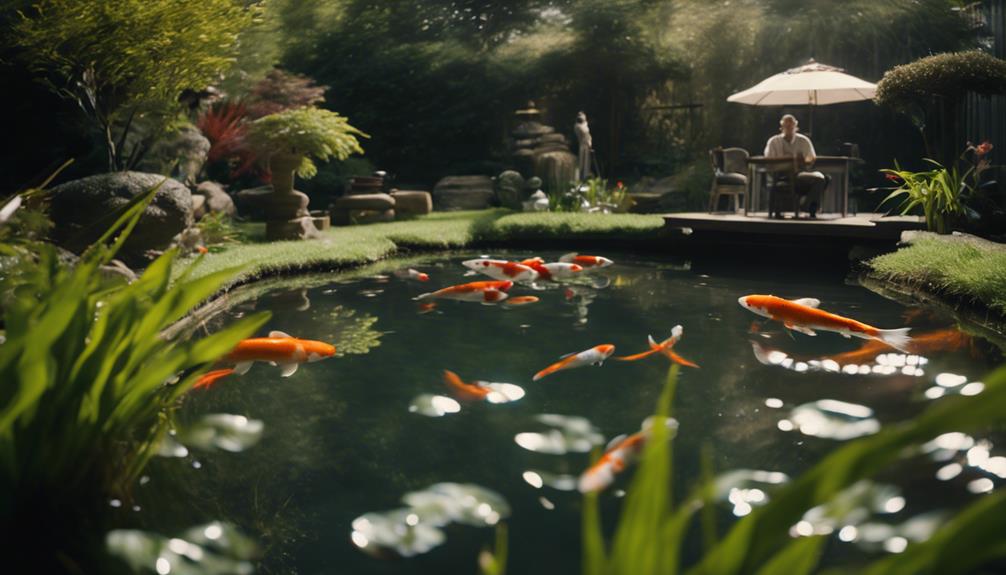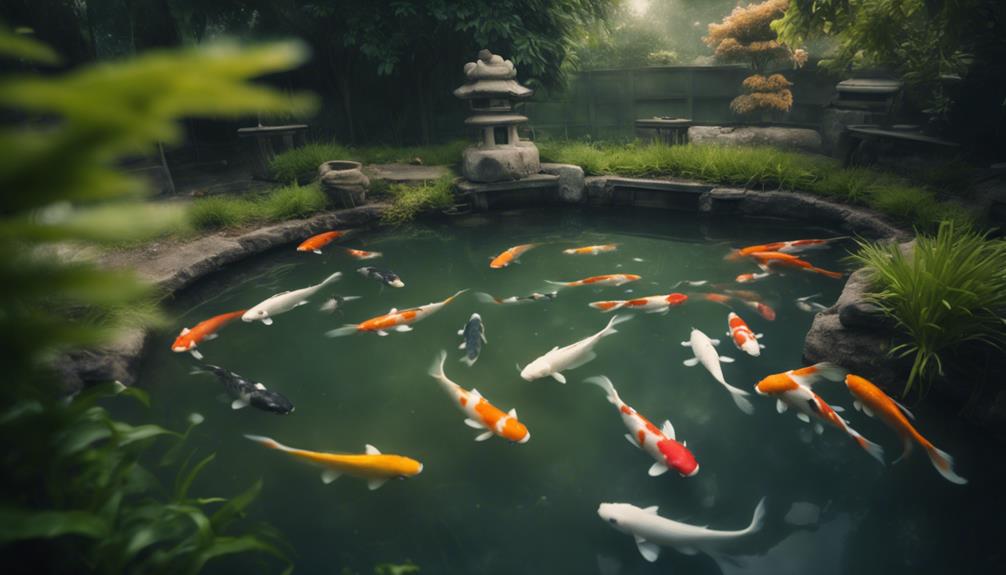You're likely familiar with the frustration of dealing with algae growth in your koi pond. But did you know that algae are a natural part of a pond's ecosystem, providing food for fish and oxygenating the water in small amounts? However, excessive growth can harm your fish and affect the pond's aesthetics. Excess nutrients, high pH levels, sunlight, and poor water circulation all contribute to algae blooms. To effectively control algae, you need to address these underlying causes. By understanding the root of the issue, you can implement a combination of preventative measures, maintain a balanced ecosystem, and enjoy a thriving pond. Now, let's explore the best strategies to achieve this.
Table of Contents
Key Takeaways
- Algae growth is fueled by excess nutrients, high pH levels, and direct sunlight, making it essential to address these underlying causes.
- A combination of preventative measures, including shade, rocks, and filter systems, can substantially reduce the likelihood of algae blooms.
- Regular water testing and maintenance are crucial in maintaining a balanced ecosystem and preventing algae growth.
- Implementing biological filters and beneficial bacteria can help break down organic matter and compete with algae for resources.
- Adopting a comprehensive plan that targets the underlying causes of algae growth is key to effective and long-term algae control in koi ponds.
Understanding Algae Growth
As you gaze into your koi pond, you may notice the water's clarity is compromised by an unsightly greenish hue, which is often a telltale sign of uncontrolled algae growth.
As a koi pond owner, understanding algae growth is vital for maintaining a healthy and thriving aquatic environment. Algae are a natural part of your pond's ecosystem, providing food for your fish and oxygenating the water in small amounts.
However, excessive growth can harm your fish and affect the pond's aesthetics. There are three main types of algae: green water algae, string or hair algae, and blue-green algae, each requiring different control methods.
To control algae growth, maintaining a balance of beneficial bacteria and nutrients in your pond water is imperative. Regular pond maintenance services can help you achieve this balance, preventing algae blooms and maintaining overall water quality.
Causes of Algae Blooms
Excess nutrients in your pond, particularly nitrogen and phosphorus, are the primary catalysts for algae blooms, setting the stage for an explosion of unwanted growth. These nutrients can come from fish waste, decaying plant matter, and lawn/garden runoff. As a pond owner, crucial to recognize is being aware of these contributors to algae growth.
| Algae Bloom Contributors | Description | Impact |
|---|---|---|
| Excess Nutrients | Nitrogen and phosphorus from fish waste, decaying plant matter, and runoff | Fuels algae growth |
| High pH Levels | pH range of 6.5-8.5 creates ideal conditions for algae growth | Encourages algae blooms |
| Sunlight | At least 10-12 hours of direct sunlight per day | Supports algae growth |
Additionally, inadequate water circulation and stagnation can lead to an overgrowth of algae, while failure to maintain a balanced ecosystem and neglecting regular pond maintenance can also contribute to algae blooms. By understanding these causes, you can take proactive steps to prevent algae growth and maintain a healthy, thriving pond ecosystem.
Effective Algae Control Methods

You're now ready to explore the most effective ways to control algae growth in your koi pond.
To achieve this, you'll need to focus on two key approaches: preventing algae growth in the first place, and restoring a natural balance to your pond's ecosystem.
Algae Prevention Strategies
Implementing a combination of preventative measures can substantially reduce the likelihood of algae blooms in your koi pond. By incorporating multiple strategies, you can create an environment that discourages algae growth and promotes a healthy ecosystem.
Some effective algae prevention strategies to ponder:
| Strategy | Description |
|---|---|
| Provide Shade | Reduce direct sunlight, which fuels algae growth, by adding plants, umbrellas, or a pond shade. |
| Adding Rocks | Increase the pond's surface area, allowing for better water circulation and oxygenation. |
| Adequate Filter System | Install a suitable filter system to remove excess nutrients and waste, reducing algae's food source. |
Additionally, you can maintain a healthy pond by reducing the nutrients available to algae. This can be achieved by controlling the amount of fish food and waste, and by introducing a biological filter to break down organic matter. By controlling algae naturally, you'll create a balanced ecosystem that's less conducive to blooms. Remember, a multi-faceted approach is key to effective pond algae control. By combining these strategies, you'll be well on your way to a thriving, algae-free koi pond.
Natural Balance Restoration
To restore a natural balance to your koi pond, focus on limiting sunlight and nutrients, which fuels algae growth, by incorporating a combination of effective algae control methods that work together to create a thriving ecosystem.
Providing shade using water lilies and implementing good circulation throughout the pond are essential steps in achieving this balance.
Biological filters play a vital role in removing dissolved nutrients from the water, allowing beneficial bacteria to grow and compete with algae for resources. These filters should be as large as possible to provide a sufficient surface area.
Mechanical filters can also be used to remove large particles and debris from the pond, preventing string algae growth.
Additionally, a UV light system can be used to effectively kill planktonic algae and speed up the balance of the pond.
Remember, a short, smooth growth of algae on pond walls is essential for establishing a natural balance.
With regular koi pond maintenance and the right combination of algae control methods, you can create a healthy and thriving ecosystem for your koi to enjoy.
Maintaining a Balanced Ecosystem
As you work to maintain a balanced ecosystem in your koi pond, you'll want to focus on three key areas: clean pond maintenance, regular water testing, and proper fish feeding.
By implementing these practices, you'll be able to prevent the buildup of debris and nutrients that fuel algae growth.
Clean Pond Maintenance
You maintain a balanced ecosystem in your koi pond by adopting a regular cleaning routine, which involves removing debris and excess nutrients that fuel algae growth. This keeps your pond clear and prevents the buildup of substances that can trigger algae blooms.
Manual removal of debris, such as fallen leaves and twigs, is an essential part of pond cleaning. Additionally, you must limit sunlight penetration, as excessive sunlight can stimulate algae growth.
Good circulation throughout the pond is also vital, as it helps to distribute oxygen and prevent stagnation. Filters can help break down organic matter and reduce the nutrient load, making it harder for algae to thrive.
Regular Water Testing
Regular water testing is essential for maintaining a balanced ecosystem in your koi pond, where fluctuating water parameters can quickly disrupt the delicate balance and trigger algae growth.
You should test your water at least once a week, or more frequently during periods of high algae growth or water changes. This will help you identify potential issues before they become severe problems.
pH, ammonia, nitrite, and nitrate levels should be verified to ensure they're within the ideal range for koi.
Alkalinity and hardness levels should be between 50-200 ppm and 5-15 dGH, respectively.
Nutrient imbalances that can contribute to excessive algae growth should be identified.
Water quality can be affected by factors like nutrient imbalances and poor water circulation.
Proper Fish Feeding
Proper fish feeding strategies are essential for maintaining a balanced ecosystem in your koi pond, as they directly impact the water's nutrient levels and, consequently, algae growth.
By providing your koi with a balanced diet that's high in fiber and low in protein, you can prevent excess nutrients from fueling algae growth.
Overfeeding koi is a common mistake that can lead to an accumulation of excess nutrients in the water, causing algae blooms.
To avoid this, only feed your koi what they can consume within a few minutes.
You can also vary their diet by including vegetables and algae-based foods, which can help reduce their nutrient output and promote a balanced ecosystem.
Implementing a regular feeding schedule and avoiding overfeeding can help reduce the amount of waste produced by koi, which in turn can help control algae growth.
Professional Pond Maintenance

Engaging a professional pond maintenance service can prove instrumental in preventing algae growth, as these experts possess the knowledge and resources necessary to implement a customized management plan tailored to the specific needs of your koi pond. By doing so, you'll be ensuring a healthy koi pond that's less prone to algae outbreaks.
To maintain a clean and balanced ecosystem, professionals will implement thorough algae control measures to keep algae at bay. They will add aquatic plants that help improve water quality and provide shelter for your fish. They will install more mechanical filtration systems to remove excess nutrients and debris. They will monitor and maintain ideal levels of nitrifying bacteria to break down waste efficiently, following the manufacturers' guidelines for best results.
Ongoing Algae Control Strategies
As you work to maintain a balanced ecosystem, you'll need to implement ongoing algae control strategies that target the underlying causes of algae growth, rather than just treating the symptoms.
One key approach is to reduce the amount of nutrients available to algae, as they need these nutrients to grow. You can help control algae by reducing the amount of organic matter that enters your pond, such as decaying plant material or excess fish food.
Beneficial bacteria can also help break down organic matter, making it unavailable to algae. Using chemical treatments or algae control products can provide short-term relief, but adopting a comprehensive plan is crucial to address the underlying causes of algae growth.
Starving the algae of nutrients is a more sustainable approach. By promoting a balanced ecosystem, you can reduce algae growth much more effectively.
Regular water testing and adjustments to your pond's ecosystem can also help prevent algae blooms. By taking a holistic approach, you can create a thriving environment for your koi and minimize the need for ongoing algae control.
Frequently Asked Questions
Is Algaecide Safe for Koi Ponds?
When considering algaecides for your koi pond, you guarantee safety by researching algae prevention methods, safe dosage levels, and reputable brand reviews, while also analyzing chemical composition to minimize pond ecosystem disruption and long-term exposure risks.
What Can I Put in My Koi Pond to Get Rid of Algae?
You're drowning in a sea of green gunk! Fear not! To rid your koi pond of algae, you can add natural algae removers like algae-eating fish, DIY algae solutions, or safe pond additives like beneficial bacteria and organic algae control measures.
What Kills Algae but Not Fish?
You can consider natural remedies like beneficial bacteria, organic treatments, and algae eaters that target algae without harming fish, or opt for technical solutions like pond aeration, water circulation, ultrasonic waves, UV lighters, algae barriers, or copper-based treatments.
Is Too Much Algae Bad for Koi Pond?
Don't you wonder, are you unwittingly cultivating a ticking time bomb in your pond? Yes, too much algae is bad for your koi pond, as it sparks an unstable ecosystem, nutrient imbalance, and water discoloration, ultimately causing fish stress and harming aquatic life.
Conclusion
You've made it this far, and now you're equipped with the knowledge to tackle algae growth in your koi pond.
By understanding the causes, implementing effective control methods, and maintaining a balanced ecosystem, you'll be well on your way to a thriving pond.
Don't forget to ponder professional maintenance and ongoing strategies to stay ahead of the game.
Remember, a healthy pond is a delicate balance of elements, and with persistence and dedication, you'll achieve a crystal-clear haven for your koi to flourish.

